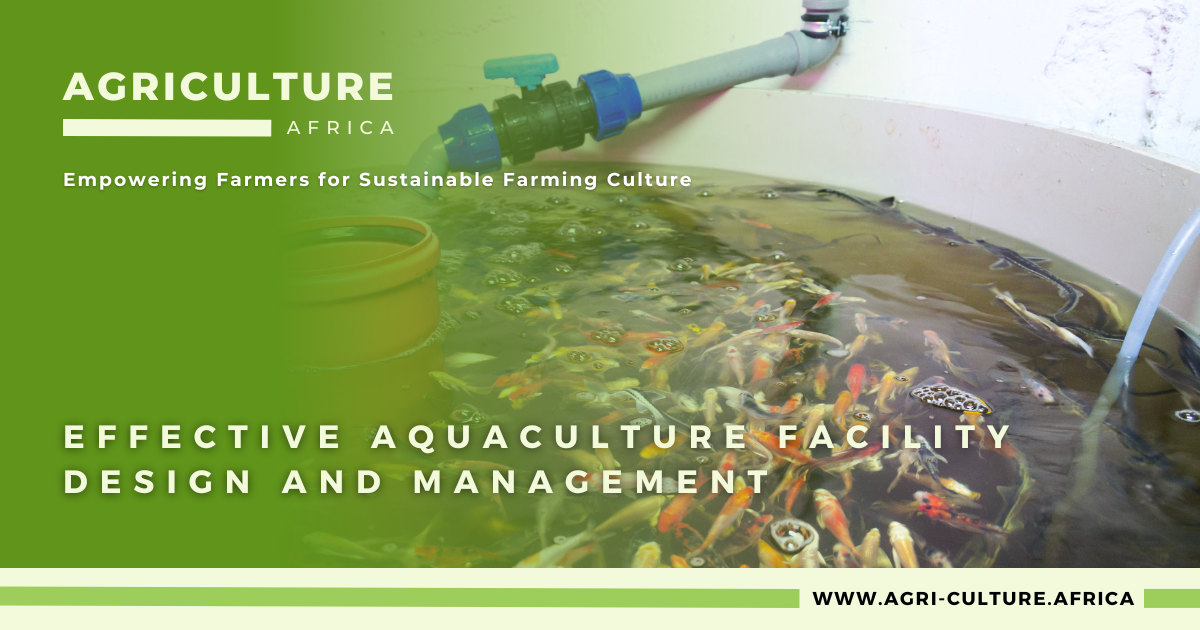
Empowering African Farmers for Sustainable Farming Culture
Aquaculture is a vital industry that provides food, jobs, and economic benefits to many countries around the world. Aquaculture facility design and management are critical to the industry’s success and sustainability. Aquaculture facility management includes water quality management, feeding and nutrition, and disease prevention. The facility design should take into account the specific needs of the target species as well as the facility’s operational requirements. Proper design and management practises can provide numerous benefits, including increased production, cost savings, and industry sustainability.
Water quality is an important consideration in aquaculture because it influences the growth, health, and survival of aquatic organisms. Aquaculture facilities should be designed and managed in such a way that the water quality is optimal for the target species. The following are critical factors to consider when managing water quality
The source of water is an important consideration in the design of an aquaculture facility. The source should be dependable and supply enough water volume for the facility. Water quality should also be appropriate for the target species. Water treatment may be required in some cases to make the water suitable for aquaculture.
Aquatic organisms require oxygen to breathe. The dissolved oxygen (DO) levels in the water should be monitored and kept at an optimal level for the target species. Low DO levels can cause stress, decreased growth, and even death in organisms.
Temperature has a significant impact on aquatic organisms’ growth, reproduction, and metabolism. The water temperature should be kept within an acceptable range for the target species. Temperature control may be required in some cases, such as in recirculating aquaculture systems (RAS) or in areas with extreme temperature fluctuations.
The pH of the water can affect the availability and toxicity of certain substances in the water. The pH should be monitored and maintained within a range that is suitable for the target species.
Salinity is an important factor in marine aquaculture. The salinity should be maintained at a level that is optimal for the target species.
Feeding and nutrition are crucial for the growth and health of aquatic organisms. Proper feeding and nutrition can improve growth rates, reduce stress, and prevent disease. The following are important factors to consider in feeding and nutrition:
The type of feed used in aquaculture can affect the growth, health, and quality of the organisms. The feed should be formulated to meet the nutritional requirements of the target species. Different types of feed are available, such as pellets, flakes, and live feed.
Feeding management is an important aspect of aquaculture. Overfeeding can lead to water quality problems, while underfeeding can lead to reduced growth rates and poor health. The feeding rate should be adjusted according to the growth rate and appetite of the organisms.
The feeding frequency can affect the growth and health of the organisms. In general, frequent feeding can improve growth rates, while infrequent feeding can reduce stress.
The feeding time can affect the feeding response and appetite of the organisms. The feeding time should be consistent to ensure optimal feeding response.
Disease prevention is an important aspect of aquaculture facility management. Diseases can lead to significant economic losses and can also pose a risk to wild aquatic populations. The following are important factors to consider in disease prevention:
Biosecurity measures should be implemented to prevent the introduction and spread of diseases in aquaculture facilities. This includes measures such as quarantine, disinfection, and pest control.
Vaccination is an effective way to prevent certain diseases in aquaculture. Vaccines are available for some species, and their use can reduce the risk of disease outbreaks.
Water quality management is also important in disease prevention. Poor water quality can weaken the immune system of the organisms, making them more susceptible to diseases. Therefore, water quality parameters such as temperature, pH, and dissolved oxygen should be carefully monitored and managed.
Regular monitoring of the health of the organisms can help identify and prevent disease outbreaks. This includes monitoring for abnormal behavior, lesions, and mortality.
The design of aquaculture facilities should consider the specific needs of the target species, as well as the operational requirements of the facility. The following are important factors to consider in facility design:
Different species have different requirements in terms of water quality, feeding, and space. The facility design should consider the specific needs of the target species to ensure optimal growth and health.
The facility design should also consider the operational requirements of the facility, such as ease of access for maintenance and harvesting, and efficient use of space and resources.
Different aquaculture systems are available, such as pond systems, flow-through systems, and recirculating aquaculture systems (RAS). The system design should be chosen based on the specific needs of the target species and the operational requirements of the facility.
Aquaculture facilities can have an impact on the surrounding environment, such as water pollution and the introduction of non-native species. The facility design should consider the potential environmental impact and implement measures to minimize the impact.
Proper design and management of aquaculture facilities can provide many benefits, including:
Proper water quality management, feeding and nutrition, and disease prevention can improve growth rates and overall health of the organisms, leading to increased production.
Efficient use of resources and proper management practices can reduce operating costs and increase profitability.
Proper design and management practices can promote sustainability of the aquaculture industry by minimizing environmental impact and promoting responsible resource use.
Your donation fuels change! Help Agriculture Culture in Africa empower farmers with resources, training, and access to innovation. Together, we can revolutionize African agriculture.
Empowering Sustainable Growth and Innovation in African Agriculture
Sign up to our newsletter